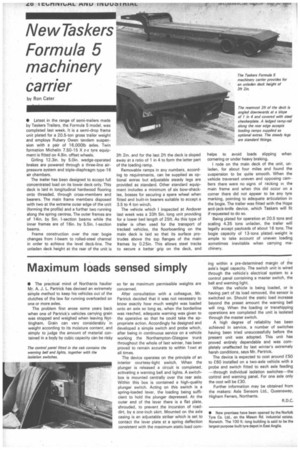Maximum loads sensed simply
Page 28

If you've noticed an error in this article please click here to report it so we can fix it.
• The practical mind of Northants haulier Mr. A. J. L. Partrick has devised an extremely simple method to keep his vehicles out of the clutches of the law for running overloaded on one or more axles.
The problem first arose some years back when one of Partrick's vehicles carrying grain was stopped and weighed when leaving Nottingham. Grain can vary considerably in weight according to its moisture content, and simply to judge the amount of material contained in a body by cubic capacity can be risky so far as maximum permissible weights are concerned.
After consultation with a colleague, Mr. Partrick decided that it was not necessary to know exactly how much weight was loaded onto an axle so long as, when the borderline was reached, adequate warning was given to the operative so that he could take the appropriate action. Accordingly he designed and developed a simple switch and probe which, after being in continuous service on a vehicle working the Northampton-Glasgow trunk throughout the whole of last winter, has been proved to remain accurate to within lcwt at all times.
The device operates on the principle of an interior courtesy-light switch. When the plunger is released a circuit is completed, activating a warning bell and lights. A switchbox is mounted centrally over the rear axle. Within this box is contained a high-quality plunger switch. Acting on this switch is a spring-loaded lever, the loading being sufficient to hold the plunger depressed. At the outer end of the lever there is a flat plate, shrouded, to prevent the incursion of road dirt, by a one-inch skirt. Mounted on the axle casing is an adjustable striker which is set to contact the lever plate at a spring deflection consistent with the maximum static load corn
ing within a pre-determined margin of the axle's legal capacity. The switch unit is wired through the vehicle's electrical system to a control panel containing a master switch, the bell and waming light.
When the vehicle is being loaded, or is having part of its load removed, the sensor is switched on. Should the static load increase beyond the preset amount the warning bell will ring. When the loading or transhipping operations are completed the unit is isolated through the master switch.
A high degree of reliability has been achieved in service, a number of switches having been tried unsuccessfully before the present unit was adopted. This unit has proved entirely dependable and was completely unaffected by last winter's extremely harsh conditions, says Mr. Partrick.
The device is expected to cost around £50 to £60 installed on a two-axle vehicle with a probe and switch fitted to each axle feeding —through individual isolation switches -the control and warning panel. For one axle only the cost will be £30.
Further information may be obtained from the makers: Axle Sensors Ltd., Queensway, Higham Ferrers, Northants.
R.D.C.












































































































